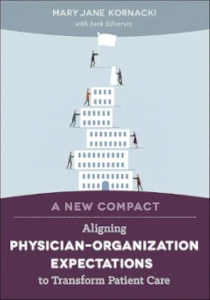Using the Physician Organization Compact to Address Provider Concerns in 2025
Author: Jack Silversin, PhD, and Mary Jane Kornacki
Published Date: February 2025
The landscape of healthcare continues to evolve, reshaping the relationship between physicians and healthcare organizations.
As evidence of this evolution, over the past 15 years, AMGA's membership has undergone a significant shift. We have seen a dramatic reversal in membership: In 2009, independent medical groups represented approximately 85% of AMGA membership, but today approximately 85% of our members are affiliated with health systems or integrated delivery networks.
This transformation has created a vastly different environment for physicians, bringing new challenges related to their engagement and satisfaction.
Additionally, 2024 marked a notable rise in physician unionization across the United States. A study published in JAMA highlighted the key drivers behind these efforts, including:
-
Working conditions (85%)
-
Lack of influence in organizational decision-making (81%)
-
Concerns about patient care (54%)
Many attribute the growing trend of unionization to the shift to an employment-based physician model and declining morale. Many employed physicians feel increasingly frustrated by decisions made at distant organizational levels, often disconnected from their daily realities. This dissatisfaction is further amplified by financial pressures, understaffing, and mounting performance demands that continue to strain the workforce. These challenges have been exacerbated by the lasting impact of COVID on the healthcare workforce and the rapid corporatization of medicine, which have intensified the burnout and strain many physicians have experienced over the past decade.
Addressing these challenges requires proactive solutions that foster collaboration and trust. One approach is the implementation of a robust organizational compact, which prioritizes open communication and emphasizes strengthening the relationship between healthcare organizations and their physicians.
What Is an Organization Compact?
An organizational compact is a written document developed by physicians and their organization’s leaders that delineates mutual roles, responsibilities, and expectations. Unlike top-down directives, a compact reflects a collaborative approach and serves as a framework for aligning both parties toward shared goals. In the process of developing a compact, both parties speak to their expectations and establish their commitment to the physician enterprise and larger system.
Traditionally, physicians have operated under an implicit compact—one that historically promised clinical autonomy, self-regulation, and a respected professional standing. However, modern healthcare demands greater standardization, efficiency, and collaboration. These evolving requirements often clash with legacy expectations, creating friction. Additionally, as integrated organizations establish leadership, many times physicians lose their voice. The compact restores their voice and sets expectations of both physicians and leaders.
A thoughtfully developed compact can serve as a tool to realign expectations and create a sense of shared purpose while addressing the pain points driving dissatisfaction.
Six Elements of a Successful Physician Compact
The success of a compact relies on a transparent, inclusive process that emphasizes collaboration and accountability. The following factors are essential in developing and implementing a compact that works:
-
Shared Vision: Establish and communicate a unifying vision for the organization that resonates with all stakeholders. A compact sets out how physicians will contribute to progress toward that vision and how administration and managers will act to achieve the shared vision and support physicians to honor their commitments.
-
Inclusive Dialogue: This is not a top-down rollout but rather a collaborative effort that ensures every voice is considered. It can't be undertaken as a way to change physicians’ behavior. At the core is acknowledging that all parties contribute to the current state and change will require some different behaviors from both parties to the compact.
-
Education: Provide physicians with a clear understanding of market and economic realities driving change in healthcare delivery. Education minimizes misconceptions and builds trust in leadership decisions.
-
Clear Reciprocal Commitments: Outline specific commitments from both administrators and physicians.
-
Accountability: There must be some mechanism for holding both physicians and administrators accountable for maintaining their compact commitments, starting with how administration will solicit and use feedback from physicians and how physician will be given feedback on how behavior does or doesn’t match stated expectations. Accountability doesn’t mean punitive measures. It does mean that a way for frank feedback from both parties is built in as the compact gets developed.
-
Living Document: A compact is not static. It should evolve as the organization changes. Regular review and discussion ensure it remains relevant and impactful.
Looking Ahead
The challenges facing physicians in 2025 are multifaceted, but they are not insurmountable. The physician organization compact represents a powerful tool to realign and clarify expectations, build culture, restore trust, and create an environment where both physicians and healthcare leaders thrive. When implemented thoughtfully, compacts move beyond symbolic gestures, driving real change through collaboration, accountability, and shared vision.
Healthcare organizations cannot afford to overlook physician dissatisfaction or the factors driving unionization. By investing in a process that enables organizations to genuinely listen to and address physician concerns, they can build stronger, more cohesive teams and deliver better outcomes for patients.
To learn more about how AMGA Consulting can help your organization develop a robust physician compact and improve organizational alignment, contact us today.
Additional Resources

For deeper insights into fostering organizational alignment and effective physician engagement, consider A New Compact: Aligning Physician–Organization Expectations to Transform Patient Care. This book explores the creation and implementation of a new compact to improve alignment in healthcare. It features seven case studies showcasing successful transformations, lessons learned, and a step-by-step guide to help organizations develop and implement their own compacts.
